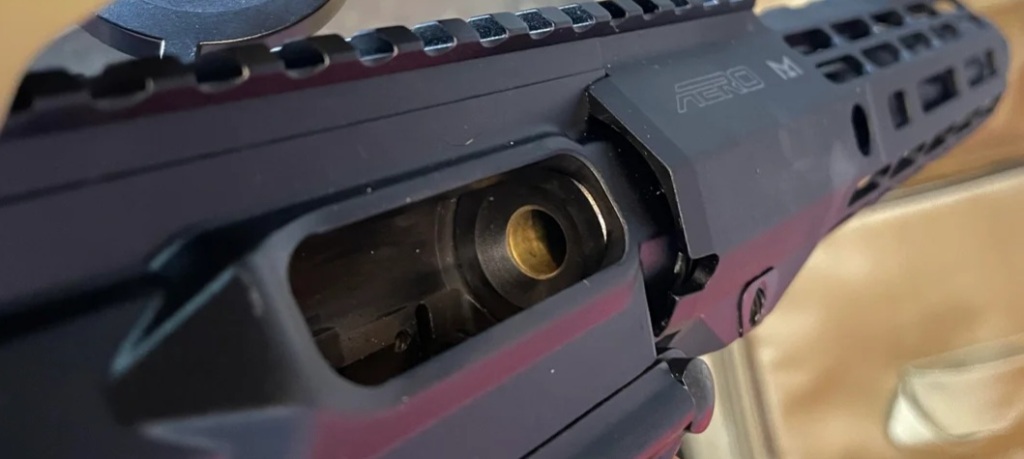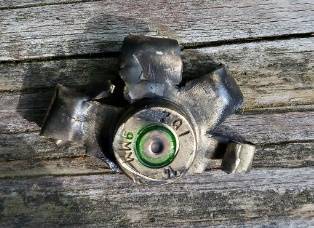This one is interesting. I’m going to try to stick to the facts, then get to how this could happen in a blowback 9mm.
This information is intended solely for entertainment purposes only. Do not perform any action based on any of the following information. The accuracy of this information is not guaranteed or warranted. Always bring malfunctioning firearms to a qualified gunsmith for repair. All copyrights and trademarks are the property of their respective owners.
A Reddit user posted the following picture:

What you see in the chamber is what is left of the brass case from a 9mm cartridge. The case head separated completely from the rest of the case, leaving the fire-formed case stuck hard in the chamber.
The Reddit user reports a loud explosion and the case head was crushed flat, but they did not have a picture of the case head and primer.
What causes case head separation?
Case head separation in a locking breech system would indicate excessive headspace. That would cause the cartridge case to stretch and rupture near the base. In a blowback system, it’s usually an indicator of extremely high pressure at the time of firing.
The details:
Let’s do some deductive reasoning. As Arthur Conan Doyle said:
“Once you eliminate the impossible, whatever remains, no matter how improbable, must be the truth.”
The following hardware configuration was reported:
- Aero receiver set
- KAK barrel
- Kaw Valley Precision bolt
- Kynshot 5007 buffer
- Springco Red recoil spring
The possiblities:
The first thing that comes to mind that this is an “out of battery discharge” (OOB). This happens when a cartridge is not fully chambered, but the firing pin somehow manages to still contact the primer. If enough of the rear of the case is not supported by the chamber, the case can blow apart.

True OOB’s are very rare in 9mm blowbacks, unless bolt bounce is involved. Because the extractor doesn’t snap over the case rim until the cartridge is chambered, the extractor prevents the case head from getting close to the breechface and firing pin. It acts as a natural “OOB safety”, helping prevent the firing pin from hitting the primer unless the cartridge has been fully chambered first and the extractor has snapped over the case rim.
Bolt bounce/OOB?
Could it have been “bolt bounce”? Bolt bounce happens when the bolt bounces backwards after chambering a cartridge, partially extracting the cartridge. If the timing is just right, the firing pin may have been traveling forward at the same time and the partially extracted cartridge bursts when the primer is struck. This only happens during rapid fire, usually only with a solid buffer, and the cartridge pieces are almost always recovered outside the chamber, not fire-formed to the chamber walls.
No/Unlikely.
The user said they were shooting very slowly, zeroing their optic.
Bad ammo?
Another possibility is bad ammo. An overcharged cartridge could have been the cause. This is common with reloads. Overcharged cartridges are generally rare for smaller manufacturers, and very rare for big manufacturers.
No/Unlikely.
The user said they were using factory fresh Federal ammunition.
Buffer/bolt mass too light?
Too little blowback mass could cause the cartridge to eject prematurely while barrel pressures are very high. This could cause a case rupture.
No/Unlikely.
The KVP bolt is advertised as weighing 14.5oz. The Kynshot 5007 is 6.1oz. This totals 20.6oz. This is a little light for 9mm blowback AR, but not too light. Some steel receiver 9mm blowback guns use as little as 14.5oz reciprocating mass (but don’t try this in an AR platform!).
Bullet setback?
Another possiblilty is “bullet setback”. This can happen when there is an alignment problem between the top cartridge in the magazine and the chamber. The cartridge can get slammed into the barrel face before it chambers, causing the bullet to “set back” into the cartridge case. This compresses the powder and leaves little room for the initial gas expansion when the cartridge fires. This can cause pressures in the cartridge to spike very high.
This can be especially concerning when it happens with a very strong recoil spring like a .308 carbine spring. These springs have enough force to ram the bullet deep into the cartridge case before firing.

The Reddit user reports that before the case head separation they did have a bullet get set “way back” into the cartridge case.
Bingo.
I think we may have the culprit.
Why: The Sprinco Red recoil spring is a very strong .308 carbine spring. It seems probable that the end user was having feeding alignment issues and the .308 spring slammed the cartridge forward so hard it crushed the bullet backward deep into the case when it misfed, and yet still managed to force the cartridge into the chamber, allowing it to fire.
The cartridge walls bonded tightly to the chamber walls because of the pressure spike and they gave out in the only place that wasn’t supported – the base. This separated the base from the cartridge, caused the explosion and loud bang, and left most of the case stuck in the chamber.
Conclusions:
First, I’ve said it many times, and I’m going to say it again, even more firmly than usual.
.308 springs (including the Sprinco Red) have no business in a 9mm blowback AR.
.308 springs have been recommended by some 9mm AR manufacturers for absolutely no good reasons and with no good rationale behind their recommendation. The only redeeming characteristic of these extremely stiff springs is that they reduce spring noise (the infamous AR “sproing” sound) because they are so rigid, and that’s not a good reason to use them in a 9mm AR.
One thing these overpowered springs CAN do very well is force cartridges to feed into the chamber when they shouldn’t, which means manufacturers of “budget quality” builds love them. They are a cheap fix for poorly aligned feeding components.
Use a standard 5.56 recoil spring with 9mm blowback AR’s. That’s more than sufficient for a 9mm AR to run properly. If it’s not feeding with a standard spring, it needs to be fixed, not forced to work incorrectly.
An unproven feed cone?
Next we need to address the feed cone on the barrel. The feed cone acts like a funnel to help feed cartridges into the chamber. If it’s done right, it can resolve many feeding alignment issues. If it’s done wrong, it could cause even more feeding issues.
It appears that KAK recently started using a brand new feed cone profile, and you can see this new design in the picture above. Unfortunately we have no idea how much (or if) it was tested or how it actually performs in real world use. Hopefully this new cone wasn’t a factor, but we’ll have to keep watch and see what users report over time.
Magazine feed height problem?
It’s possible that the Reddit user’s magazines may not be sitting in the magwell at the most optimal height or angle for feeding. This can be a problem with 9mm lowers that use the steep-angled Glock magazines or when using aftermarket Glock-compatible magazines. As of right now this is just speculation, so if I find anything definitive I’ll add more details.